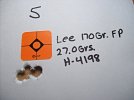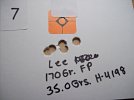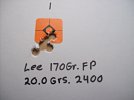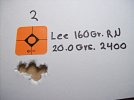Spindrift
Well-Known Member
The Lee c309- family of bore- riders is kind of organized in pairs, each round- nosed bullet having a slightly lighter, flat- nosed sibling.
The 120-R, and the 113-F
The 160-R, and the 150-F
The 180-R, and the 170-F
The 200-R, and the... wait! What happened to the c309-190-F? Kind of shame they never made it, it would be useful to many people.
Anyway, I got a 2-cav c309-170-F a while ago. I cast some bullets, for some reason using my soft BHN 11 range scrap. I usually use this for subsonic loads. I put on my home- made alu gas checks, coated them and then forgot about them.
These bullets resurfaced the other day, and I decided to shoot them in my Howa 1500, .308win
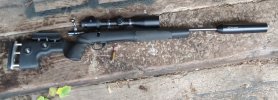
I didn’t know what a soft bore-rider could take with powder coat, I decided to do a little «stress test». 37 grs Vectan Tubal-5000, which is an extruded single-base typical .308win powder. The listed starting load for 180grs jacketed, is 35,5grs. My bullets weighed in at 176grs.
I ran the noses into a .302 NOE nose sizer, which didn’t so much size the nose, as smooth out some high spots. Which is all you can expect from this sizer concept.
COL set to a little jump. All cartridges fed smoothly from the magazine.
Point of impact was more or less to point of aim at 100m, the rifle is zeroed at 150m with a full-power 185grs jacketed bullet. I shot 4 groups of 5 shots, average c-c 1,3MOA. Below is the best, and the worst group.
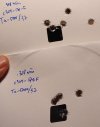
I also shot a bullet into water containers. 5 litre windshield- fluid containers are now the most common test medium around here, as you can get them for free at any gas station.
For reference, in the 30-06, a 180grs Interlock typically penetrate 5 containers. A 180-grs bonded bullet manages 6 such containers, and a 200grs bonded bullet 7.
I had expected this soft bullet to more or less blow up at almost mid-range jecketed load levels. Well, the containers sure blew up.... The fist two were completely ruptured. There were some lead fragments in the second and third container. The bullet actually penetrated through the 6th container, cracked the rear wall of the 6th and bounced back.
Retained weight 130grs (75%), the bullet was .413 when it came to rest.
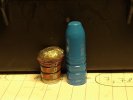
Surprisingly good!
It acted kind of like a partition bullet; rapid expansion, moderate fragmentation resulting in a shank of modest expanded diameter with deep penetration.
This load will not win any competitions, or anything. But this seems to be a well balanced, reliable, useful load!
Edit: typo
The 120-R, and the 113-F
The 160-R, and the 150-F
The 180-R, and the 170-F
The 200-R, and the... wait! What happened to the c309-190-F? Kind of shame they never made it, it would be useful to many people.
Anyway, I got a 2-cav c309-170-F a while ago. I cast some bullets, for some reason using my soft BHN 11 range scrap. I usually use this for subsonic loads. I put on my home- made alu gas checks, coated them and then forgot about them.
These bullets resurfaced the other day, and I decided to shoot them in my Howa 1500, .308win

I didn’t know what a soft bore-rider could take with powder coat, I decided to do a little «stress test». 37 grs Vectan Tubal-5000, which is an extruded single-base typical .308win powder. The listed starting load for 180grs jacketed, is 35,5grs. My bullets weighed in at 176grs.
I ran the noses into a .302 NOE nose sizer, which didn’t so much size the nose, as smooth out some high spots. Which is all you can expect from this sizer concept.
COL set to a little jump. All cartridges fed smoothly from the magazine.
Point of impact was more or less to point of aim at 100m, the rifle is zeroed at 150m with a full-power 185grs jacketed bullet. I shot 4 groups of 5 shots, average c-c 1,3MOA. Below is the best, and the worst group.

I also shot a bullet into water containers. 5 litre windshield- fluid containers are now the most common test medium around here, as you can get them for free at any gas station.
For reference, in the 30-06, a 180grs Interlock typically penetrate 5 containers. A 180-grs bonded bullet manages 6 such containers, and a 200grs bonded bullet 7.
I had expected this soft bullet to more or less blow up at almost mid-range jecketed load levels. Well, the containers sure blew up.... The fist two were completely ruptured. There were some lead fragments in the second and third container. The bullet actually penetrated through the 6th container, cracked the rear wall of the 6th and bounced back.
Retained weight 130grs (75%), the bullet was .413 when it came to rest.

Surprisingly good!
It acted kind of like a partition bullet; rapid expansion, moderate fragmentation resulting in a shank of modest expanded diameter with deep penetration.
This load will not win any competitions, or anything. But this seems to be a well balanced, reliable, useful load!
Edit: typo
Last edited:

